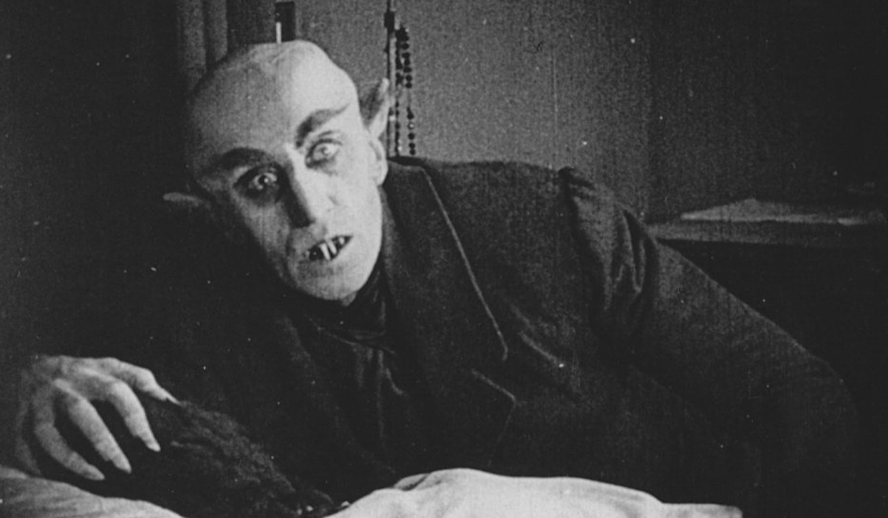Table of Contents

Photo: ‘Nosferatu’
Injecting Scares into Silent Cinema
You may struggle to think of a movie you’ve seen that came out prior to 1920; indeed, you might have almost as hard a time with any movie released prior to 1930. The silent era is mostly forgotten now, being relegated to the status of antiquity, with a few exceptions like Charlie Chaplin’s work from that period. However, so much of what we know, and how we understand Cinema on a basic level, comes from the silent era—although, curiously, most of the important movies released between 1915 and 1930 did not come from Hollywood, or even from English-speaking countries.
Related article: OSCAR-NOMINATED – EXCLUSIVE: ‘Dune’ Full Commentary, Reactions, Making Of – Timothee Chalamet, Zendaya, Oscar Isaac
Related article: OSCAR-NOMINATED – ‘House of Gucci’ Full Commentary & Behind the Scenes – Lady Gaga, Adam Driver, Jared Leto, Al Pacino
Related article: OSCAR-NOMINATED – ‘Belfast’ Full Commentary & BTS – Jamie Dornan, Caitriona Balfe, Judi Dench
Related article: OSCAR-NOMINATED – ‘West Side Story’ Full Commentary – Rita Moreno, Steven Spielberg, Rachel Zegler
Related article: OSCAR-NOMINATED – ‘No Time to Die’ Full Commentary, Behind the Scenes & Reactions, Daniel Craig, Rami Malek, Bond
Consider F. W. Murnau’s 1922 masterpiece, ‘Nosferatu.’ It’s hard to evaluate ‘Nosferatu’ with fresh eyes because, to put it simply, it’s the most important horror movie ever made; it’s not the best, or the scariest, but it served as the blueprint which horror in Cinema for decades afterward would use, either openly or indirectly. Vampires (arguably the most “classic” of fictitious monsters) had been depicted on the big screen before (albeit not often), but ‘Nosferatu’ would codify certain tropes related to vampire fiction that we now take for granted, as I’ll explain later. The success of ‘Nosferatu’ was at least threefold, setting up Murnau as one of the biggest filmmakers of his time, being a huge catalyst for both vampire movies and horror movies at large, and as one of the defining examples of the German expressionist movement.
I’ll note that there are spoilers, but keep in mind that this movie is quite literally a hundred years old now, and loosely based on a novel that’s even older.
The Oldest Surviving Adaptation of Dracula
Even by 1922, Bram Stoker’s seminal horror novel Dracula was popular — popular enough to warrant adaptations in the new medium of Cinema. ‘Nosferatu’ is the oldest surviving film adaptation of Dracula, and by extension, it’s the oldest depiction of Count Dracula. Except he’s not called Count Dracula. There is debate as to why characters’ names were changed for ‘Nosferatu’, but regardless, Count Dracula is now Count Orlok, Jonathan Harker is now Thomas Hutter, etc. The adaptation had not been given the go-ahead by Stoker’s widow (Stoker having passed away in 1912), and a legal battle ended in a call to have all prints of the film destroyed.
Related article: EVOLUTION: Every Henry Cavill Role From 2001 to 2021, All Performances Exceptionally Poignant
Related article: EVOLUTION: Every Chris Evans Role From 1997 to 2020, All Performances Exceptionally Poignant
It’s probably hard to comprehend nowadays that a film could so easily become lost media, but this was by no means uncommon in the silent era. Prints are fragile and highly flammable, and even with big-budget productions from that time period, it’s all too easy to lose the negative that had gone through the actual camera which had shot the movie. Movies from the 1910s and ‘20s are often ignored due to their apparent age, and I suspect this is not helped by the fact these movies look very old indeed, only surviving via second-and-third-generation prints that are of lower quality than the now-lost negative. ‘Nosferatu’, even when restored for high definition, looks pretty crusty now, although the crustiness has the inadvertent effect of making the movie appear even more surreal, more disconnected from what we recognize as normalcy.
‘Nosferatu’ was directed by F. W. Murnau and shot by Fritz Arno Wagner (with additional photography by Günther Krampf), with all three being fairly early in their careers. Murnau would later direct one of the greatest silent American films with ‘Sunrise: A Song of Two Humans’ in 1927, and he would have probably moved to direct “talkies” if not for his untimely death in 1931. Wagner would work regularly with fellow German filmmakers Fritz Lang and G. W. Pabst, but sadly, ‘Nosferatu’ was his last collaboration with Murnau.
Related article: #metoo Revolution: Powerful Questions That Need Answers
Related article: FACT-CHECKED Series: Timothee Chalamet and 32 Facts about The Young Superstar
A Bad Dream Brought to the Silver Screen
Expressionism is an umbrella term for a certain school of artistic thought — a school of thought that encompasses Cinema, painting, architecture, literature, and God knows what else. With expressionism in Cinema, though, can be traced mostly to German productions from the late 1910s to when the Nazis came to power. Whereas realism aims for grounded set design, naturalistic acting, and a sort of dour worldview, expressionism aims to be unreal. One of the reasons why American filmmakers during the silent era are now forgotten (with the big exception of Buster Keaton) is that they usually aimed for theatricality or realism — which, when taken today, don’t hold up very well. The deliberate artificiality of expressionist films like ‘Nosferatu’ and ‘The Cabinet of Dr. Caligari’ tap into the region of the mind that normally doesn’t come into contact with the waking world — the region that plays with dreams.
Whereas realistic films want everything to be crystal clear, like everything happens in broad daylight, expressionist films prefer the shadows and paranoia of nighttime. It can be hard to tell when anything in ‘Nosferatu’ takes place at night, since everything was shot day-for-night and it’s a black-and-white movie, but it always feels like it takes place at night. Orlok is about as purely an expressionist figure as you can get, in this way; he sleeps during the day, and sunlight is what kills him. Indeed, Hutter’s extreme slowness to react to the threat of Orlok can be somewhat forgiven if one treats Orlock as more of an apparition than as a person; even so, Hutter is far from the sharpest tool in the shed. There is a primordial, irrational terror, though, when Hutter finds Orlok asleep in his coffin, his eyes open, more catatonic than actually sleeping. While vampires are often portrayed as sexy, if not overflowing with eroticism, Orlok is surely one of the most ghoulish vampires in Cinema’s history.
Related article: MUST WATCH – The Hollywood Insider’s CEO Pritan Ambroase’s Love Letter to Black Lives Matter – VIDEO
Subscribe to The Hollywood Insider’s YouTube Channel, by clicking here.
The castle, where much of the action in the first half happens, is itself a great setting for nightmares, helped by the lack of obvious sets. In silent films (and a lot of early sound films, come to think of it), it was standard practice to use sets (what we would now call sound stages) for filming, but the locations in ‘Nosferatu’ are mostly real. When Hutter travels to Transylvania to sell a house to Orlok, the exteriors — the eerie landscapes — were actually filmed in central Europe. Generally, this is a movie that feels like it’s haunted by the ancient castles and rolling hills that would have populated much of 19th century Europe, before the onset of iron and firebombs.
Max Schreck: The First Great Horror Performance
Orlok is not the lead character of ‘Nosferatu’, but he has by far and away the most memorable presence. Gustav von Wangenheim’s performance as Hutter would be considered perfectly fine for 1922, but nowadays, he comes off as annoyingly over-the-top and weirdly absent-minded. Greta Schröder as Ellen (Mina in Stoker’s novel) gives a pretty haunting performance, actually, but she has to wait until the third act to put her skills on full display. No, the real star of the show is Max Schreck as Orlok, and this truly is one of the most iconic performances in film history. Despite never hearing his voice (as it’s a silent movie), and despite his character not being nearly as complex as his novel counterpart, Orlok remains an unnerving creation — the subject of homage, replication, parody, and analysis for the next century.
Limited Time Offer – FREE Subscription to The Hollywood Insider
As said before, vampires are usually depicted as attractive creatures, being prone to seducing their human victims; you might hesitate to call a vampire a “monster,” really. However, Orlok has no interest in seduction, nor is he a sight for sore eyes; he has these pointy goblin-like ears, thick eyebrows, a hawkish nose, fingers that seem a little too long, a creepily tall and lanky figure, and a set of rodent-like teeth. The makeup work on Max Schreck is nothing short of phenomenal, especially given the restrictions of the time, but all of that would go to waste if not for Schreck’s inhuman movements. One of my favorite moments of the movie is when Orlok steps through a doorway, and it occurs to us that the door frame almost perfectly matches Orlok’s figure — a realization made far more effective because of how slowly Schreck steps through the door.
Max Schreck embodies his role so fully that it’s easy to think that maybe he was a vampire in real life; Schreck was more or less a normal guy, albeit something of a recluse, but that doesn’t stop frivolous speculation. Most memorably, the making of ‘Nosferatu’ was told in a highly fictitious fashion in the Oscar-nominated horror-comedy ‘Shadow of the Vampire’, starring John Malkovich as F. W. Murnau and Willem Dafoe as actually-a-vampire Max Schreck. For all its accomplishments as a horror movie, ‘Nosferatu’ can probably thank Schreck’s performance for its status as an all-time classic.
Related article: The Hollywood Insider’s CEO Pritan Ambroase: “The Importance of Venice Film Festival as the Protector of Cinema”
Related article: The Masters of Cinema Archives: The Hollywood Insider Pays Tribute to ‘La Vie En Rose’, Exclusive Interview with Director Olivier Dahan
Related article: – Want GUARANTEED SUCCESS? Remove these ten words from your vocabulary| Transform your life INSTANTLY
‘Nosferatu’ – Setting the Standard for Vampire Movies
If you have read Dracula, then you may recall that Dracula himself is not killed by sunlight; indeed, there doesn’t seem to be a single depiction of vampires prior to ‘Nosferatu’ where sunlight proves lethal. The decision to defeat Orlok with sunlight was apparently made on a whim, and Murnau certainly couldn’t have known that such a decision would impact vampire lore forevermore after that. Vampires in fiction tended to be averse to daytime prior to ‘Nosferatu’, but this was the first time vampires were made out to be totally nocturnal. While Orlok’s ghoulish nature runs counter to most vampire depictions, the occasional depiction of vampires as closer to beasts than humans (‘30 Days of Night’ comes to mind) are all but guaranteed to be taking inspiration from ‘Nosferatu.’
Since ‘Nosferatu’ is an adaptation of Dracula (albeit an unauthorized one), it remains probably the most famous adaptation of that novel. Yes, even more famous than the actually authorized 1931 adaptation, starring Bela Lugosi. Lugosi’s rendition of Count Dracula would, of course, become extremely influential for future portrayals of vampires, but his performance is not a scary one; it (like the film as a whole, in my opinion) has lost much of its bite. Max Schreck’s Orlok, however, is still one of the great horror movie villains, and I reckon that if someone my age were shown ‘Nosferatu’ and the 1931 version of ‘Dracula’ back-to-back, the former would come out looking stronger.
Since it’s in the public domain, ‘Nosferatu’ is readily available in a variety of formats, including just watching it for free on YouTube.
By Brian Collins
Click here to read The Hollywood Insider’s CEO Pritan Ambroase’s love letter to Cinema, TV and Media. An excerpt from the love letter: The Hollywood Insider’s CEO/editor-in-chief Pritan Ambroase affirms, “We have the space and time for all your stories, no matter who/what/where you are. Media/Cinema/TV have a responsibility to better the world and The Hollywood Insider will continue to do so. Talent, diversity and authenticity matter in Cinema/TV, media and storytelling. In fact, I reckon that we should announce “talent-diversity-authenticity-storytelling-Cinema-Oscars-Academy-Awards” as synonyms of each other. We show respect to talent and stories regardless of their skin color, race, gender, sexuality, religion, nationality, etc., thus allowing authenticity into this system just by something as simple as accepting and showing respect to the human species’ factual diversity. We become greater just by respecting and appreciating talent in all its shapes, sizes, and forms. Award winners, which includes nominees, must be chosen on the greatness of their talent ALONE.
I am sure I am speaking for a multitude of Cinema lovers all over the world when I speak of the following sentiments that this medium of art has blessed me with. Cinema taught me about our world, at times in English and at times through the beautiful one-inch bar of subtitles. I learned from the stories in the global movies that we are all alike across all borders. Remember that one of the best symbols of many great civilizations and their prosperity has been the art they have left behind. This art can be in the form of paintings, sculptures, architecture, writings, inventions, etc. For our modern society, Cinema happens to be one of them. Cinema is more than just a form of entertainment, it is an integral part of society. I love the world uniting, be it for Cinema, TV. media, art, fashion, sport, etc. Please keep this going full speed.”
More Interesting Stories From The Hollywood Insider
– Want GUARANTEED SUCCESS? Remove these ten words from your vocabulary| Transform your life INSTANTLY
– A Tribute to Martin Scorsese: A Complete Analysis of the Life and Career of the Man Who Lives and Breathes Cinema
– Do you know the hidden messages in ‘Call Me By Your Name’? Find out behind the scenes facts in the full commentary and In-depth analysis of the cinematic masterpiece
– A Tribute To The Academy Awards: All Best Actor/Actress Speeches From The Beginning Of Oscars 1929-2019 | From Rami Malek, Leonardo DiCaprio To Denzel Washington, Halle Berry & Beyond | From Olivia Colman, Meryl Streep To Bette Davis & Beyond
– In the 32nd Year Of His Career, Keanu Reeves’ Face Continues To Reign After Launching Movies Earning Over $4.3 Billion In Total – “John Wick”, “Toy Story 4”, “Matrix”, And Many More
nosferatu, nosferatu, nosferatu, nosferatu, nosferatu, nosferatu, nosferatu, nosferatu, nosferatu, nosferatu, nosferatu, nosferatu, nosferatu, nosferatu, nosferatu, nosferatu, nosferatu, nosferatu, nosferatu, nosferatu, nosferatu









